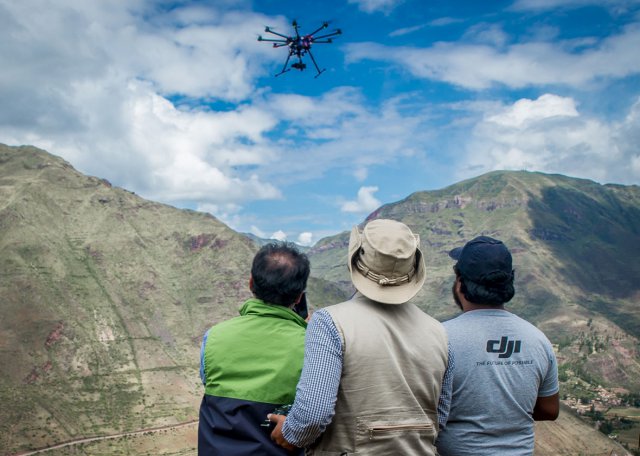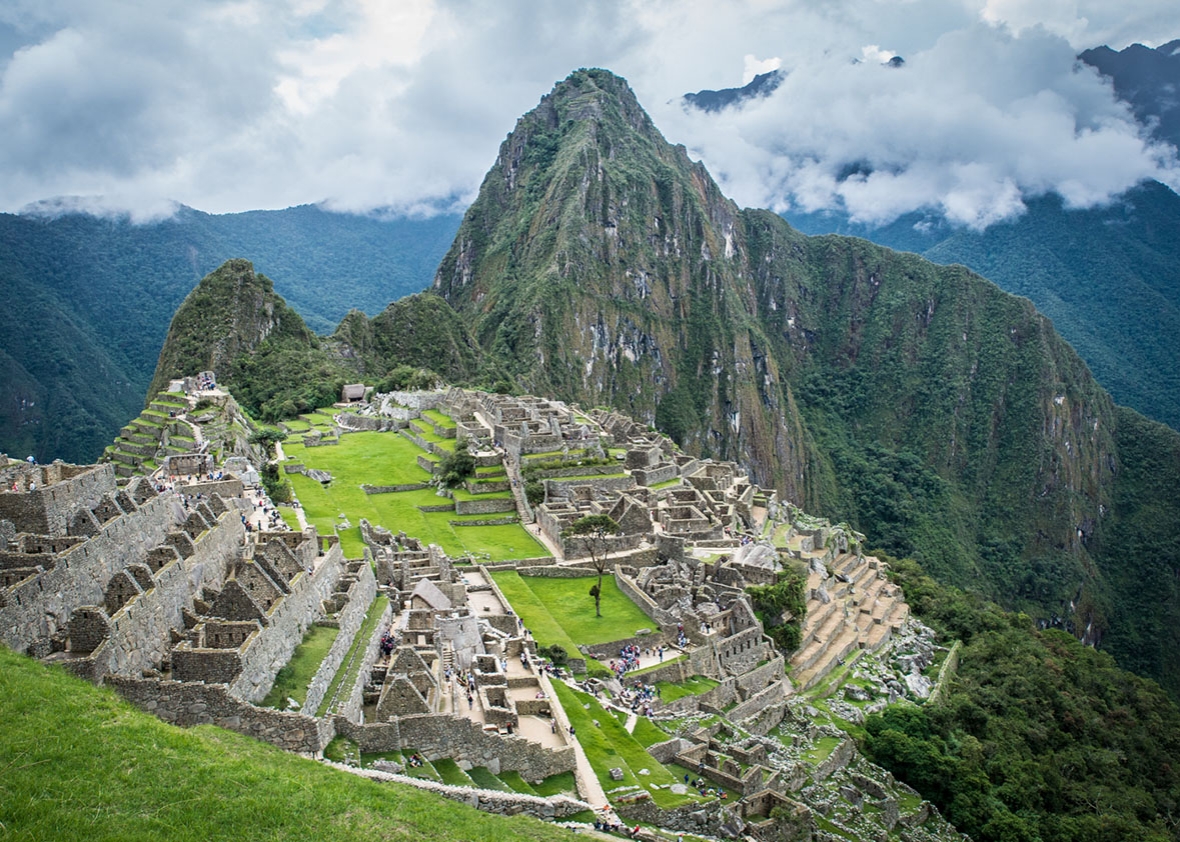
Members of Peru’s Ministry of Culture drone team watch a DJI S1000 octocopter in flight at the ruins of Pisaq in the Sacred Valley in April 2015.
Founded in 2013 by Luis Jaime Castillo Butters, the former deputy minister of cultural heritage and cultural industries, Peru’s drone archaeology team has quickly become one of the most active in the world, working to accurately survey and preserve the South American nation’s thousands of valuable archaeological sites.
At the beginning, team members had no special engineering expertise or any prior experience with unmanned aerial vehicles, or UAVs. But in just two years, they have become an authority on this specific area of drone mapping, with archaeologists and drone pilots from around the world now reaching out to them for advice. “Anybody can do the work we do. Anybody can work with the drones, anybody can work with the software, anybody can produce the stuff we are producing,” Castillo explains. “We are simply doing it on a scale that is actually having a real impact on cultural patrimony.”
Since the program began, the Ministry of Culture’s drone team has mapped more than 600 sites, allowing it to create standardized records of archaeological data at a much faster pace than was possible in the days of ground-based surveying. The group has developed a relatively standardized process for its archaeological missions, primarily using Chinese drone maker DJI’s Spreading Wing S1000 “octocopters” for their mapping projects. The hefty drones are equipped with Sony NEX-7 mirrorless cameras and can stay in the air for roughly 15 minutes, but their battery life decreases when flying at a high altitude, as is often the case in Peru.
 The drone team’s process begins with marking out at least three ground-control points in the area to be mapped, which can be identified from the sky with the assistance of a highly visible marker. Next, the archaeologists use a differential GPS unit to accurately survey (asses the location of) each point. The drone team assesses the weather—and also makes sure that any people on the ground are aware of what’s happening. When the all-clear is given, it’s time for liftoff.
The drone team’s process begins with marking out at least three ground-control points in the area to be mapped, which can be identified from the sky with the assistance of a highly visible marker. Next, the archaeologists use a differential GPS unit to accurately survey (asses the location of) each point. The drone team assesses the weather—and also makes sure that any people on the ground are aware of what’s happening. When the all-clear is given, it’s time for liftoff.
In simplest terms, aerial maps are made by combining hundreds of different photos—I wrote about this process in detail in New America’s new Drones and Aerial Observation primer. (New America is a partner with Slate and Arizona State in Future Tense.) To make sure the photos overlap enough, the drone has to fly in a specific pattern—it’s easy to think of this as the pattern a lawnmower makes as it traverses the lawn, with straight lines overlapping to ensure no spots are missed. Although many drone mappers program their devices to fly themselves in a predetermined pattern, Watanave is wary of automatic drone flight, thanks to the painful memory of a recent drone crash caused by a failed autopilot. Instead, the Peruvian pilots eyeball the pattern and fly it themselves at an altitude between 196 and 262 feet, shooting a photograph every 2 to 3 seconds.
Once shooting is over, it’s time for the archaeologists to use Agisoft Photoscan photogrammetry software to stitch the photographs together into a single image. The aerial maps and 3-D models that archaeologists use have to be geographically accurate—applicable to the real world and capable of being layered on top of pre-existing maps—so the software geometrically corrects (orthorectifies) the images so that they have a uniform scale.
The process may be relatively straightforward, but fieldwork has its own perils, from angry French tourists to technical error to simple poor luck. The $3,300 octocopters are relatively sturdy, but they’re definitely breakable. Not that this vulnerability stops the archaeologists: During my visit to Peru, I watched, impressed, as the team floated the drone (packed in a waterproof case) from the shore of an inflatable raft onto the rocky coast of an island somewhere off the coast near Lima. Two archaeologists walked the hefty box and its robotic cargo up the steep path to the top of the island they’d been sent to survey in punishing heat, as vultures watched their progress.
The drone flights are indisputably valuable for archival and research purposes, but as Castillo and Watanave soon discovered, they’re a good way to document current abuses of archaeological sites as well. Peru’s middle class is growing, and land is at a premium, meaning that ancient ruins are often threatened by building. In a famously embarrassing incident, a 4,000-year-old pyramid at the El Paraíso archaeological site was knocked down by developers, while in February 2015, the archaeological site of Farfán in Cajamarca was leveled and fenced in by a man who claimed to own the property (a claim the Ministry of Culture, unsurprisingly, contests).

Builders often claim ignorance of the boundaries of archaeological sites as an excuse for destroying them, and until the advent of drones, it was an argument that was rather hard to contradict. Not anymore: The drones allow archaeologists to inexpensively create photographic maps that clearly show where state-maintained ruins end and private property begins, making it harder for builders to argue that they lacked clear guidelines. What’s more, the drones can provide irrefutable photographic evidence of damage that’s already taken place. Using mapping software, authorities are even able to overlay photographic maps of the site produced at different times over one another, producing precise evidence of where damage has taken place.
With these aerial techniques, it’s easier to catch and to fine offenders and—Castillo hopes—potential builders will begin to think twice about doing such damage in the first place. “In the First World, the more we know, the better we can act, the more responsible the state is in this regard,” he says. “In the underdeveloped world, the less we know, the more we can get away with murder. That’s the point.”

They’ve also used the drones to shame Greenpeace. In December 2014, as U.N. climate change talks took place in Lima, Greenpeace activists decided to unfurl a large anti–climate-change banner at Peru’s iconic Nazca Lines, beside the massive image of a hummingbird. What the environmental activists didn’t take into account was the delicacy of the barren terrain surrounding the ancientgeoglyph—any disturbance can cause irreversible damage. Justifiably angered, the Ministry of Culture flew one of its UAVs over the scene of the incident. The resulting aerial imagery clearly documented the outlines of the banner right next to the enormous image of a hummingbird, as well as tracks to the site created by the activists’ footprints. The incriminating footage was broadcast on news networks around the world, and Greenpeace later made a formal apology.
In the near future, the Peruvian archaeologists plan to use the drone imagery to create an easily accessible online repository: an inexpensive record of Peruvian cultural history useful to both researchers and the general public. It could help preserve what looting, natural disasters, and development might destroy. Particularly excitingly, the full potential of the technology has by no means been realized. “The more we work, the more applications we find for it [drone technology], for things we hadn’t even thought about,” explains Castillo.
Watanave and Castillo—who left the Ministry of Culture in June and is now advising on other archaeological projects—are by no means the only people with visions of using drone technology and photogrammetry to create virtual archaeological records. Interesting projects that rely on new drone mapping technology are being carried out from Jordan to Turkey to Guatemala, using aerial maps and 3-D modeling to document historical sites, conduct new research, and even to analyze the behavior of looters.
What’s more, 3-D modeling and photogrammetry techniques aren’t just applicable to landscapes: The same techniques are also being used to scan historical objects and works of art, at lower prices than were possible in the past and with exacting detail, from vases to sculptures to dinosaur skeletons. In the very near future, it’s easy to imagine a virtual museum where 3-D models of archaeological sites are paired with digitized versions of historical objects, perhaps viewable through next-generation virtual reality goggles, such as the widely touted Rift, produced by Oculus VR.
The new, nonprofit organization Culturalmap is already using 3-D scanning technology to create models of historical objects that are then linked to a specific location on a map. More projects along the lines of Peru’s repository are likely to follow in other locations, thanks to the increasingly low cost and ease of use of the technology.
In the near future, perhaps, average interested people and archaeological professionals will have access to the same virtual historical record, permitting anyone with an Internet connection to conduct research on (or just learn about) the past. And drones—good for more than just shooting cool YouTube videos—will help make it happen.
Source: Slate
